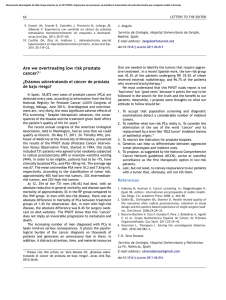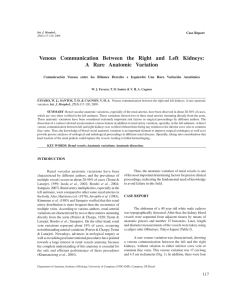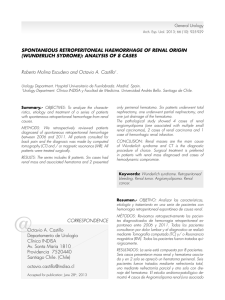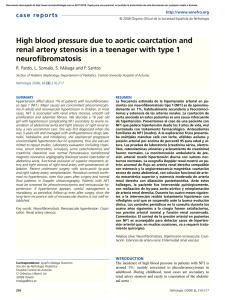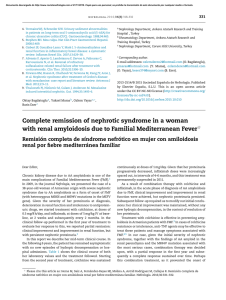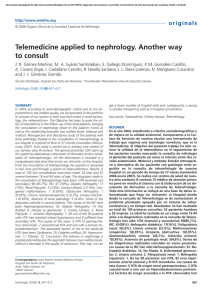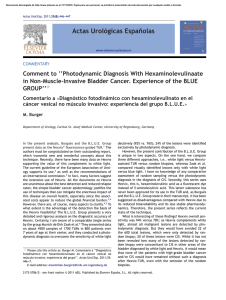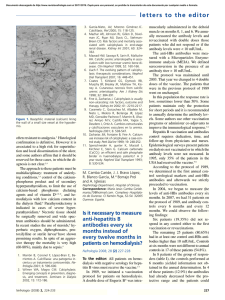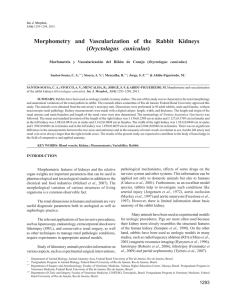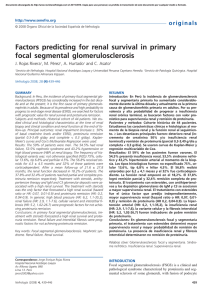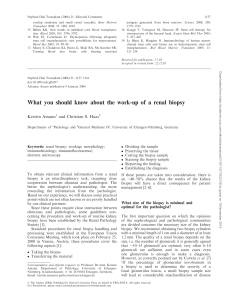A new case of malignant fibrous histiocytoma arising from
Anuncio
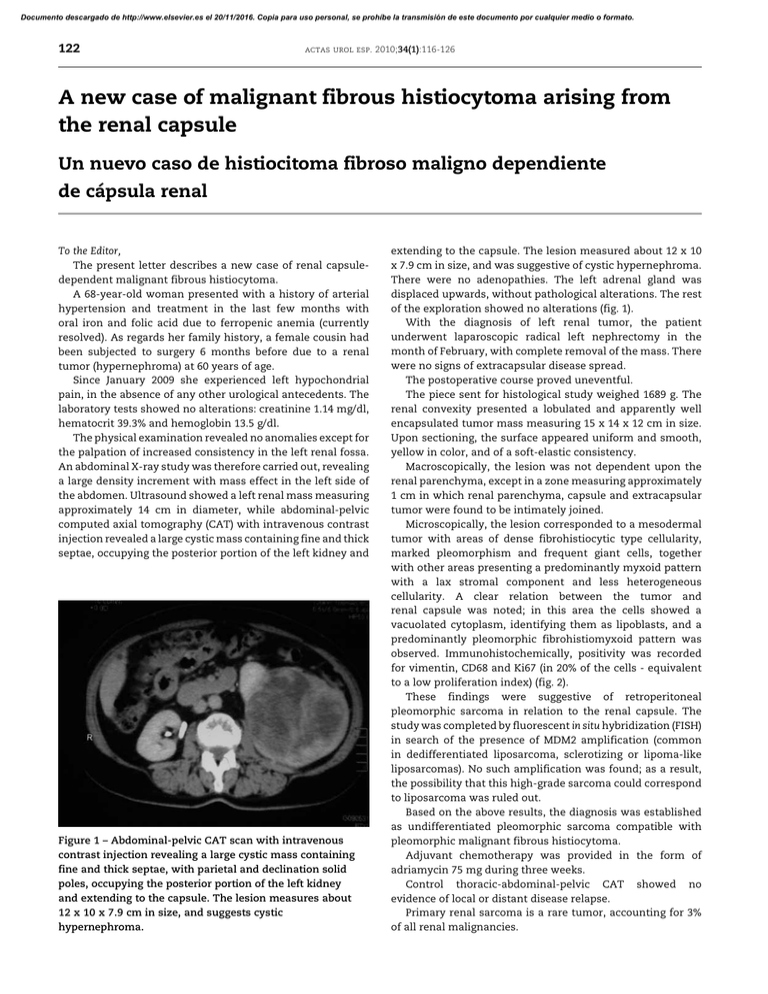
Documento descargado de http://www.elsevier.es el 20/11/2016. Copia para uso personal, se prohíbe la transmisión de este documento por cualquier medio o formato. 122 actas urol esp. 2010;34(1):116-126 A new case of malignant fibrous histiocytoma arising from the renal capsule Un nuevo caso de histiocitoma fibroso maligno dependiente de cápsula renal To the Editor, The present letter describes a new case of renal capsuledependent malignant fibrous histiocytoma. A 68-year-old woman presented with a history of arterial hypertension and treatment in the last few months with oral iron and folic acid due to ferropenic anemia (currently resolved). As regards her family history, a female cousin had been subjected to surgery 6 months before due to a renal tumor (hypernephroma) at 60 years of age. Since January 2009 she experienced left hypochondrial pain, in the absence of any other urological antecedents. The laboratory tests showed no alterations: creatinine 1.14 mg/dl, hematocrit 39.3% and hemoglobin 13.5 g/dl. The physical examination revealed no anomalies except for the palpation of increased consistency in the left renal fossa. An abdominal X-ray study was therefore carried out, revealing a large density increment with mass effect in the left side of the abdomen. Ultrasound showed a left renal mass measuring approximately 14 cm in diameter, while abdominal-pelvic computed axial tomography (CAT) with intravenous contrast injection revealed a large cystic mass containing fine and thick septae, occupying the posterior portion of the left kidney and Figure 1 – Abdominal-pelvic CAT scan with intravenous contrast injection revealing a large cystic mass containing fine and thick septae, with parietal and declination solid poles, occupying the posterior portion of the left kidney and extending to the capsule. The lesion measures about 12 x 10 x 7.9 cm in size, and suggests cystic hypernephroma. extending to the capsule. The lesion measured about 12 x 10 x 7.9 cm in size, and was suggestive of cystic hypernephroma. There were no adenopathies. The left adrenal gland was displaced upwards, without pathological alterations. The rest of the exploration showed no alterations (fig. 1). With the diagnosis of left renal tumor, the patient underwent laparoscopic radical left nephrectomy in the month of February, with complete removal of the mass. There were no signs of extracapsular disease spread. The postoperative course proved uneventful. The piece sent for histological study weighed 1689 g. The renal convexity presented a lobulated and apparently well encapsulated tumor mass measuring 15 x 14 x 12 cm in size. Upon sectioning, the surface appeared uniform and smooth, yellow in color, and of a soft-elastic consistency. Macroscopically, the lesion was not dependent upon the renal parenchyma, except in a zone measuring approximately 1 cm in which renal parenchyma, capsule and extracapsular tumor were found to be intimately joined. Microscopically, the lesion corresponded to a mesodermal tumor with areas of dense fibrohistiocytic type cellularity, marked pleomorphism and frequent giant cells, together with other areas presenting a predominantly myxoid pattern with a lax stromal component and less heterogeneous cellularity. A clear relation between the tumor and renal capsule was noted; in this area the cells showed a vacuolated cytoplasm, identifying them as lipoblasts, and a predominantly pleomorphic fibrohistiomyxoid pattern was observed. Immunohistochemically, positivity was recorded for vimentin, CD68 and Ki67 (in 20% of the cells - equivalent to a low proliferation index) (fig. 2). These findings were suggestive of retroperitoneal pleomorphic sarcoma in relation to the renal capsule. The study was completed by fluorescent in situ hybridization (FISH) in search of the presence of MDM2 amplification (common in dedifferentiated liposarcoma, sclerotizing or lipoma-like liposarcomas). No such amplification was found; as a result, the possibility that this high-grade sarcoma could correspond to liposarcoma was ruled out. Based on the above results, the diagnosis was established as undifferentiated pleomorphic sarcoma compatible with pleomorphic malignant fibrous histiocytoma. Adjuvant chemotherapy was provided in the form of adriamycin 75 mg during three weeks. Control thoracic-abdominal-pelvic CAT showed no evidence of local or distant disease relapse. Primary renal sarcoma is a rare tumor, accounting for 3% of all renal malignancies. Documento descargado de http://www.elsevier.es el 20/11/2016. Copia para uso personal, se prohíbe la transmisión de este documento por cualquier medio o formato. 123 actas urol esp. 2010;34(1):116-126 Malignant fibrous histiocytoma is the most frequent sarcoma in adults (0.2-0.6%, and most often located in the soft tissues of the extremities), and is very rare in childhood. Between 12-15% of these lesions are located in the retroperitoneum, and their origin from the renal capsule or tissue components of the renal hilum is exceptional. A number of theories have been proposed to explain their origin – some suggesting tumor cell derivation from histiocytes, and other from pluripotent mesenchymal cells. The classification is based on the microscopic findings, establishing the following variants: 1. Fibrous giant cell tumors: a) storiform or “cartwheel” presentations, b) pleomorphic (the most frequent in this group of tumors), and c) fascicular 2. Inflammatory 3. Myxoid (the most frequent presentation, and with the best prognosis)) The clinical manifestations are dependent upon the size of the tumor, and are very unspecific. The lesions can grow to a large size, due to their retroperitoneal location, before causing symptoms – this contributing to delay the diagnosis of the disease. Nevertheless, the most common symptom is pain in the affected renal fossa, accompanied by constitutional syndrome for the past several months. The initial diagnosis is based on the imaging findings, which offer information on the composition, density, extent and relation to adjacent organs and structures, with the identification of displacement of the kidney, the ureter or bladder in relation to the tumor. Although malignant fibrous histiocytoma is clinically and radiologically indistinguishable from renal carcinoma, the condition should be suspected in the presence of certain radiological features: a) tumors measuring over 10 cm in size at the time of diagnosis, with no invasion of the renal parenchyma or renal vein or vena cava; b) tumors showing various intensities in the MRI images (areas that appear hypodense in T1- and T2-weighted sequences, reflecting the fibrous components; areas the appear hypodense in T1and hyperdense in T2-weighted sequences, reflecting cystic degeneration, necrosis or regions with abundant histiocytic cells); c) tumors appearing to be hypovascular or avascular at angiography; d) tumors with hypodense areas corresponding to multilocular cystic degeneration, and hyperdense areas corresponding to calcifications in CAT scans. The definitive diagnosis is established by the pathology findings. Macroscopically, these are large and multilobulated tumors, of a yellow-gray color, with hemorrhagic areas containing necrotic zones. Microscopically, extensive pleomorphism is seen, comprising fibroblastic cells and histiocytes. Immunohistochemically, the tumors show positivity for CD68 and chymotrypsin. The only treatment with healing intent is complete surgical removal of the tumor. In some cases such resection must be extended to adjacent organs as well, in order to guarantee radical removal. The surgical approach depends on the location, characteristics and extent of the lesion. Figure 2 – Microscopic view of undifferentiated pleomorphic sarcoma compatible with pleomorphic malignant fibrous histiocytoma, dependent on the renal capsule, with isolated visualization of parenchyma, renal capsule and tumor. In general, the prognosis is poor, with a 60% survival rate after two years, and a recurrence rate of 50-82%. The most frequent targets of metastatic spread are the lungs (the most common location), the liver, bone and bone marrow. Complementary treatment with radiotherapy and chemotherapy is controversial, and has not been shown to increase global survival. As regards chemotherapy, the reference drug in such patients is adriamycin combined with DTIC (dimethyltriazene-imidazole-carboxamide) or vincristine. R E C O M M E N D E D L I T E R A T U R E Argüelles Salido E, Congregado Ruiz CB, Medina López MA, Pascual del Pobil Moreno JL. Histiocitoma maligno fibroso retroperitoneal. Actas Urol Esp. 2004;28(8):624-6. Eroglu M, Bakirtas H, Cimentepe E, Unsal A, Ataoglu O, Balbay MD. Malignant fibrous histiocytoma arising from the renal capsule. Urol Int. 2005;75(4):368-70. Gabbert H, Wagner R, Becht E. Malignant fibrous histiocytoma of the renal capsule. J Cancer Res Clin Oncol. 1981;100(3): 285-93. Gimeno Argente V, Bosquet Sanz M, Gómez Pérez L, Delgado Oliva FJ, Arlandis Guzmán S, Jiménez Cruz JF. Histiocitoma fibroso maligno retroperitoneal con infiltración de órganos vecinos. Actas Urol Esp. 2007;31(5):562-6. Gupta R, Gupta S, Aggarwal D, Singh S. Primary pleomorphic undifferentiated sarcoma of the kidney: a rare renal tumor. Indian J Pathol Microbiol. 2008;51(4):574-5. Gutiérrez Mínguez E, Arroyo Muñoz JL, Espiga Santamaría J. Malignant fibrohistiocytoma of the renal capsule. Report of a case and review of the literature. Actas Urol Esp. 1996;20(8):744-5. Kanno T, Kamoto T, Terai A, Kakehi Y, Terachi T, Ogawa O. A case of malignant fibrous histiocytoma arising from the renal capsule. Hinyokika Kiyo. 2001;47(2):95-8. Documento descargado de http://www.elsevier.es el 20/11/2016. Copia para uso personal, se prohíbe la transmisión de este documento por cualquier medio o formato. 124 actas urol esp. 2010;34(1):116-126 Kitajima K, Kaji Y, Morita M, Okuda Y, Sugimura K. Malignant fibrous histiocytoma arising from the renal capsule. Magn Reson Med Sci. 2004;4(2):199-202. López JI, Angulo JC, Flores N, Toledo JD. Malignant fibrous histiocytma of the renal capsule and synchronous transitional cell carcinoma of the bladder. Pathol Res Pract. 1996;192(5):468-73. Matsui Y, Kobayashi S, Sugino Y, Iwamura H, Oka H, Fukuzawa S, et al. Malignant fibrous histiocytoma originating in a renal capsule: a case report. Hinyokika Kiyo. 2001;47(10):727-9. R. Sierra Labarta*, M.J. Gil Sanz, G. Muñoz González and L.A. Rioja Sanz Servicio de Urología, Hospital Universitario Miguel Servet, Zaragoza, Spain *Author for correspondence. E-mail: [email protected] (R. Sierra Labarta). Treatment with hydroxocobalamin for cyanide poisoning: A rare cause of pseudohematuria Tratamiento con hidroxicobalamina para la intoxicación por cianuro: una causa rara de pseudohematuria To the Editor, A 59-year-old male was admitted to the Emergency Service of our hospital after triple suicide attempt, accompanied by manifest hematuria. The three suicide attempts comprised setting the home on fire, followed by a failed shotgun shot to the head, and finally a fall from the thirteenth floor. Upon arrival in the Emergency Service, the patient was hemodynamically stable, the physical examination revealing Figure 1 – (A) Left hemifacial trauma with important tissue loss due to gunshot wound. (B) Urine leakage is seen, with “Bordeaux red” staining.

